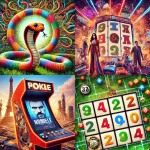Imagine yourself in a familiar coffee shop: A guest is sitting by the window playing online slots Canada, others are vividly discussing something at the next table, a manager comes up and asks you … to list the basic rules of thermodynamics. You look around in surprise and realize that on the chalkboard there are not new items on the menu, but the topic of the lesson; that the guests are arguing about solving the problem; and instead of a manager, he is the teacher, and the action itself takes place in a virtual environment that is surprisingly similar to school. This is what educational activities in the MMORPG world might look like.
What Is the Point of MMORPGs?
MMORPGs are massively multiplayer online role-playing games. The presence of the virtual world, the different paths to character development and virtual social interaction remain unchanged. The latter is so close to real-life interaction that games are even used for research. For example, social psychologist Sherry Turkle found that many players have a broader emotional sphere than a control group. She suggested that this is due to the different roles that players get into through their characters.
The very structure of the game world corresponds to the ideas of constructivist pedagogy: Knowledge appears only as a result of joint work on a problem. Ultimately, it all depends on the player’s goal. Whether he wants to become the slayer of dragons, the best athlete in the world, or study any discipline, the methods are the same — you need to make some effort and work with a group to achieve the goal.
MMORPG as a Tool
The MMORPG genre has many good examples: Lineage II, World of Warcraft, Star Wars: The Old Republic. Even those who are far from the world of gamers have probably come across one of the names. Of course, these games were not created for the needs of the school. The creative approach of teachers made them educational. Here are some techniques for using online role-playing games in teaching.
World of Warcraft
This game, which tells of the confrontation between the Alliance and the Horde, entered the Guinness Book of World Records as the most popular MMORPG in the world. Participants will have to fight side by side and complete tasks. World of Warcraft is provided on a monthly paid subscription, and it is possible to play for free up to level 20 (you can register here).
In the game, you can use, for example, the knowledge of discrete mathematics and analyze the degree of damage per second. The task will be formulated as follows: “Purchase two types of weapons. Using targets, find the average damage over time for each weapon. ” You can complicate the task by adding equipment to the condition that changes agility, attack power or other statistics.
In language or literature lessons, schoolchildren can receive the following assignment: “In science fiction literature, the bard plays a key role as a traveling musician and storyteller. What song or poem do the bards of Azeroth sing about your character’s adventures?” The instructor may invite students to write a haiku about their experience of the game or riddles about the Warcraft races.
In social studies lessons, students can formulate the missions of their guilds, using the example of the goals prescribed by real organizations:
“The mission should include the following points:
- The purpose of the guild.
- The main members of the guild.
- Duties of the guild to its members.
- Services provided by the guild to its members.
In this case, the mission cannot be longer than a paragraph; at least two other mission statements must be commented on. The price of this task is 250 experience points. ”
Second Life
This game is a virtual world with elements of a social network. Its members can lead surprisingly “real” lives: creating goods, owning land, being in communities, traveling. A basic account can be created for free. Although Second Life is intended for people over the age of 16, educators have the ability to create safe spaces within the game for their students.
In the virtual world, there are universities, libraries and many organizations are represented, from the Dresden Art Gallery to the International Museum of Space Flight. You can even create a copy of your own school, designed with the wishes of the students; for example, put an aquarium with tropical fish in the hallway and a popcorn machine in the dining room. Second Life makes it possible to simulate almost any real-life scenario, from starting a virtual business to seeing a psychologist, which greatly increases its educational potential.
For a history lesson, a museum island is suitable, on which more than 30 monuments of the Mediterranean and the Middle East have been recreated. In geography, schoolchildren can go on a scientific expedition to Antarctica to see how scientists live and work in this cold area and how they collect and analyze ice samples — the key to the history of climate on our planet. And what kind of student would pass up flying through a hurricane or seeing a tsunami?
The role of the teacher, in this case, is of paramount importance, since he becomes a kind of quest master. It is about transferring not only knowledge but also moral values. The absolute freedom of the player in the MMORPG is programmatically and ethically limited: You cannot go beyond the map, but you cannot take credit for yourself, the virtual property of other participants, etc. Second Life regularly hosts a round table on education in virtual worlds. Anyone can join.
Improvements in MMORPGs will lead to even greater realism and interactivity, bringing with them innovative models and ways of learning. The line between face-to-face education and virtual learning environments can become blurred.
Today you can listen to the programs of the leading universities in the world or get an academic degree without leaving your home. Online courses create a type of student who does not personally know the teacher or classmates. Against this backdrop, the virtual worlds of MMORPGs offer benefits by maintaining all the convenience of distance learning and at the same time providing students and teachers with the ability to interact directly with each other.
The secrets of MMORPGs’ appeal can be used in curricula regardless of internet access. To do this, the teacher needs to think about:
- Continuity of tasks — so that solving one leads to the next.
- Interesting storyline —which fosters competition and makes players more motivated.
- Flexibility — several ways to achieve a goal, the ability to develop your own strategy.
- Rewards — At the end of each challenge, successful players gain new abilities, areas to explore or missions.
Conclusion
As a conclusion, it should be noted that gamification is a great addition to any teacher’s lesson. The game can liven up the learning process and make it more fun for children. It is important to remember though that a computer game is an auxiliary component that allows you to present information more clearly. It would be wrong to use this method exclusively in teaching.
















